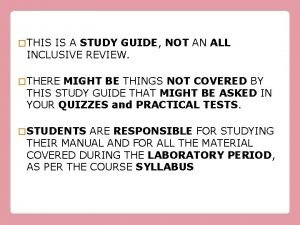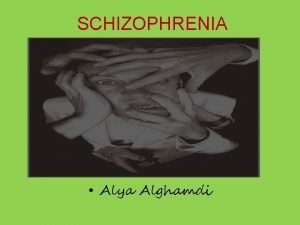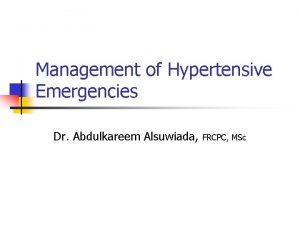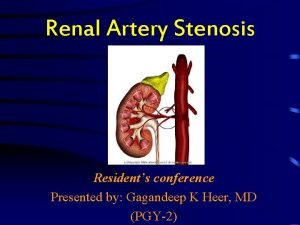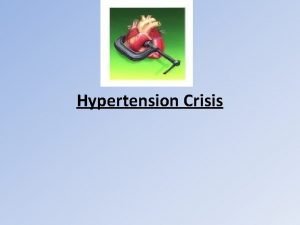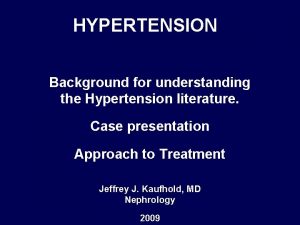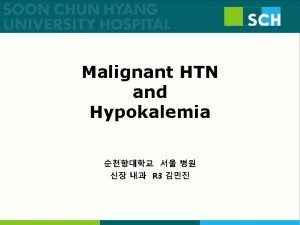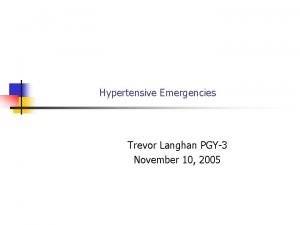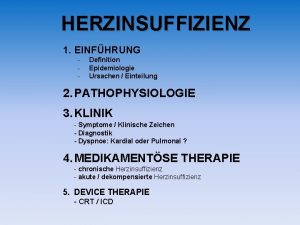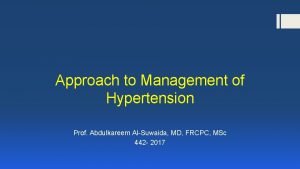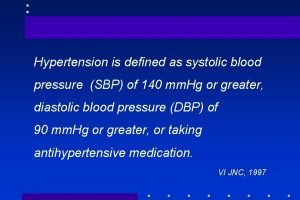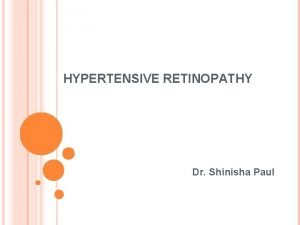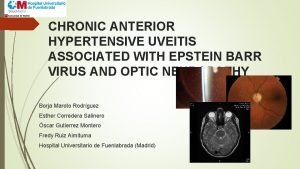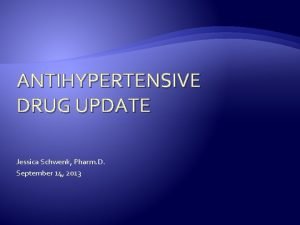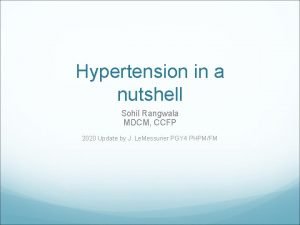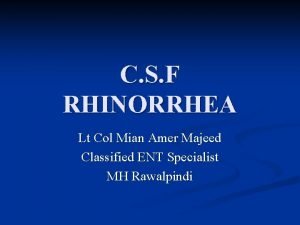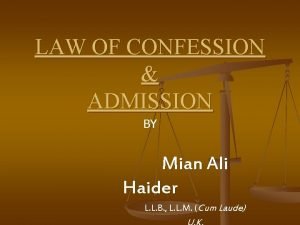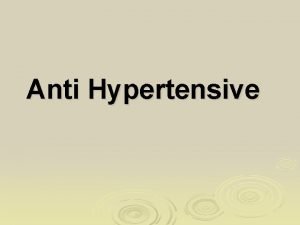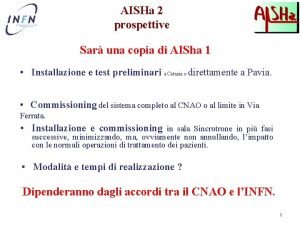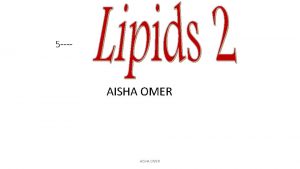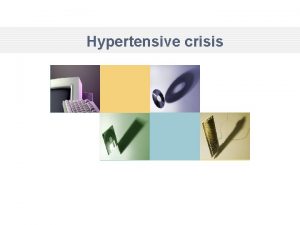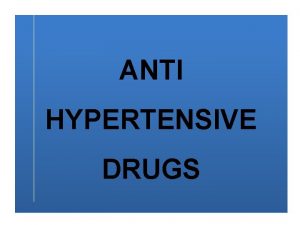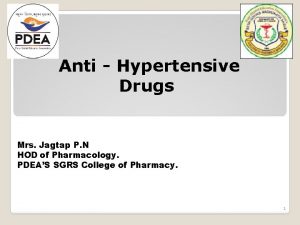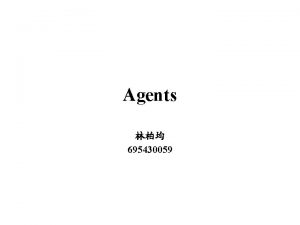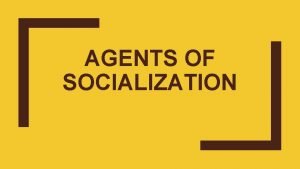Anti Hypertensive Agents Dr Aisha ALGhamdi Associate professor




























- Slides: 28

Anti Hypertensive Agents. Dr. Aisha AL-Ghamdi Associate professor Consultant internist 1

Ø Antihypertensives are a class of drugs that are used in medicine and pharmacology to treat hypertension. Ø Evidence suggests that reduction of the blood pressure by 5 -6 mm. Hg can decrease the risk of Stroke by 40%, Coronary heart disease by 15 -20% and reduces the likelihood of dementia, heart failure, and mortality from cardiovascular disease. 2

Antihypertensive groups Diuretics. Ø Adrenergic receptor antagonists. Ø Adrenergic receptor agonist. Ø Calcium channel blockers. Ø Angiotensin-converting enzyme inhibitors. Ø Angiotensin II receptor antagonists. Ø Aldosterone antagonists. Ø Vasodilators. Ø Centrally acting adrenergic drugs. Ø 3

DIURETICS Ø help the kidneys eliminate excess salt and water from the body's tissues and blood. Ø Loop diuretics: l l bumetanide ethacrynic acid furosemide torsemide 4

CONT. Thiazide diuretics Ø chlortalidone Ø epitizide Ø hydrochlorothiazide and chlorothiazide Ø bendroflumethiazide 5

CONT. Thiazide-like diuretics: Ø indapamide Ø chlorthalidone Ø metolazone Potassium-sparing diuretics: Ø amiloride Ø triamterene Ø spironolactone 6

CONT. Ø Only the thiazide and thiazide-like diuretics have good evidence of beneficial effects on important endpoints of hypertension, and hence, should usually be the 1 st choice when selecting a diuretic to treat hypertension 7

CONT. The reason why thiazides-type diuretics are better than the others is because of 1. Their vasodilating properties. 2. The diuretic effect of thiazides may be apparent shortly after administration. 3. The full anti-hypertensive effect to develop. takes longer (weeks of treatment). {disadvantage !!} 8

Adverse effects of thiazides ; 1. 2. 3. 4. 5. Hypokalemia → arrhythmias Hyperuricaemia → acute gout. increase serum LDL- cholesterol and TG. Impair glucose tolerance and increase insulin resistance. Reports of frank diabetes are rare. Although thiazides probably should be avoided as first-line drugs in patients with diabetes and hyperlipidaemia. Rarer side effects include nausea, headache, rashes, photosensitivity and blood dyscrasias. 9

Adrenergic receptor antagonists Beta blockers; (no longer 1 st line therapy in many countries) atenolol, metoprolol, nadolol, oxprenolol, pindolol, propranolol, timolol. Ø Alpha blockers; Doxazosin, phentolamine, indoramin, phenoxybenzamine, prazosin , terazosin, tolazoline. Ø Mixed Alpha + Beta blockers; bucindolol, carvedilol, labetalol. Ø 10

beta-receptor Ø Ø Ø Types →ß 1 ß 2 ß 3 Vasodilation (b 2) Cardioacceleration (b 1) Intestinal relaxation (b 2) Uterus relaxation(b 2) Bronchodilation (b 2) 11

Adverse effects of b-blockers; Ø slow the rate of conduction at the atrio- ventricular node. Ø Sinus bradycardia is common and is not a reason to stop beta-blockers unless the patient is symptomatic or the heart rate falls below 40 beats/minute. 12

contraindicated in; Ø Patients with 2 ndand 3 d degree heart block. Ø Asthmatics Ø rest ischaemia of the legs (Blockade of b receptors in the peripheral circulation → vasoconstriction) Ø Diabetics (theoretically, reduce the awareness of low blood glucose →mask hypoglycemic symptoms). 13

Adrenergic receptor agonist. Alpha-2 agonists Revise (α-receptors sites, function) l l clonidine methyldopa 14

alpha-receptor Types → α 1 (A, B, D) , α 2 (A, B, C) Ø Vasoconstriction Ø iris dilation Ø intestinal relaxation Ø intestinal sphincter contraction Ø bladder sphincter contraction 15

Calcium channel blockers Block the entry of calcium into muscle cells in artery walls. Ø Dihydropyridines; l l l l Ø amlodipine felodipine isradipine lercanidipine » peripheral vasodilatation→ reflex tachycardia. nifedipine(Adalat®) nimodipine nitrendipine Non-dihydropyridines; diltiazem , verapamil. » peripheral vasodilatation+ ↓ HR. 16

Adverse effects of Ca. CB; Vasodilatation causes ankle oedema, headache, flushing and palpitation. Some of these side effects can be offset by combining a calcium channel blocker with a b-blocker. Verapamil, Diltiazem can cause heart block and reduces intestinal motility. significant constipation may be occurred. 17

ACE inhibitors captopril Ø enalapril Ø fosinopril Ø lisinopril Ø perindopril Ø quinapril Ø ramipril Ø trandopril Ø benzapril Ø 18

Adverse effects of ACEI; Cough commonest, more in females and older patients. Ø Angioedema more serious, but rare, which occurs in about 0. 1 to 0. 2 per cent of patients. Ø Ø Dramatic deterioration in renal function can occur in patients with bilateral renal artery stenosis. Serum urea and creatinine should, therefore, be checked before and a few weeks after starting an ACE inhibitor. 19

Angiotensin II receptor antagonists Ø Ø Ø Ø Angiotensin II receptor antagonists work by antagonizing the activation of angiotensin receptors. candesartan eprosartan irbesartan losartan olmesartan telmisartan valsartan 20

Adverse effects of Angiot. II R. A. Ø hyperkalaemia, renal impairment and hypotension. They are almost as well tolerated as placebo. Nevertheless, cases of angioedema have been reported with some of these agents. 21

Aldosterone antagonists Ø Eplerenone. Ø Spironolactone. Aldosterone antagonists are not recommended as first-line agents for blood pressure, but spironolactone and eplerenone are both used in the treatment of heart failure. 22

Vasodilators act directly on arteries to relax their walls so blood can move more easily through them; used in medical emergencies. Ø sodium nitroprusside used in medical emergencies. Ø Hydralazine. 23

Centrally acting adrenergic drugs Ø Clonidine, Guanabenz, Methyldopa , Central alpha agonists lower blood pressure by stimulating alpha-receptors in the brain which open peripheral arteries easing blood flow. Central alpha agonists, such as clonidine, are usually prescribed when all other antihypertensive medications have failed. For treating hypertension, these drugs are usually administered in combination with a diuretic. 24

CONT. Ø Adverse effects of this class of drugs include sedation, postural hypotension, drying of the nasal mucosa and rebound hypertension. Ø Some adrenergic neuron blockers are used for the most resistant forms of hypertension: Ø Guanethidine Ø Reserpine 25

CONT. Ø These drugs are old antihypertensive agents but still have a role in some special situations ex. Pregnancy, resistant HT. Ø Considered cheap drugs. 26

Drugs used in treatment of HT in pregnancy Ø Hydralazine. Ø Methyldopa. Ø Labetalol. quiz. what is the group of each drug? adverse effects? 27

The choice between the drugs; Ø Weighing side effects & cost and patient clinical situation ! Examples: asthmatics have been reported to have worsening symptoms when using beta blockers. sometimes the presence of other symptoms can warrant the use of one particular antihypertensive (such as beta blockers in case of tremor and nervousness. 28
 Promotion from assistant to associate professor
Promotion from assistant to associate professor Anti a anti b anti rh blood type
Anti a anti b anti rh blood type Schizophrenia dsm 5
Schizophrenia dsm 5 Hemmorragie
Hemmorragie Htn emergency vs urgency
Htn emergency vs urgency Hypertensive emergency definition
Hypertensive emergency definition Anatomy blood vessels
Anatomy blood vessels Case scenario for hypertension
Case scenario for hypertension Hypertensive crisis
Hypertensive crisis Hypertensive crisis management
Hypertensive crisis management Hypertensive encephalopathy
Hypertensive encephalopathy Hypertensive encephalopathy
Hypertensive encephalopathy Cattle trucking retina
Cattle trucking retina Meto zerok gewichtszunahme
Meto zerok gewichtszunahme Hypertensive urgency vs emergency
Hypertensive urgency vs emergency Calcium channel blockers examples
Calcium channel blockers examples Deflection of veins at av crossing
Deflection of veins at av crossing Hypertensive uveitis
Hypertensive uveitis Hypertensive urgency vs emergency
Hypertensive urgency vs emergency Sohil rangwala
Sohil rangwala Llxxx
Llxxx Aisha mian leaked
Aisha mian leaked Aisha mian cum
Aisha mian cum Aisha holloway
Aisha holloway Shakira aisha
Shakira aisha A poem that tells a story. *
A poem that tells a story. * Aisha bint abu bakr quotes
Aisha bint abu bakr quotes Aisha walcott
Aisha walcott Aisha dawood
Aisha dawood

